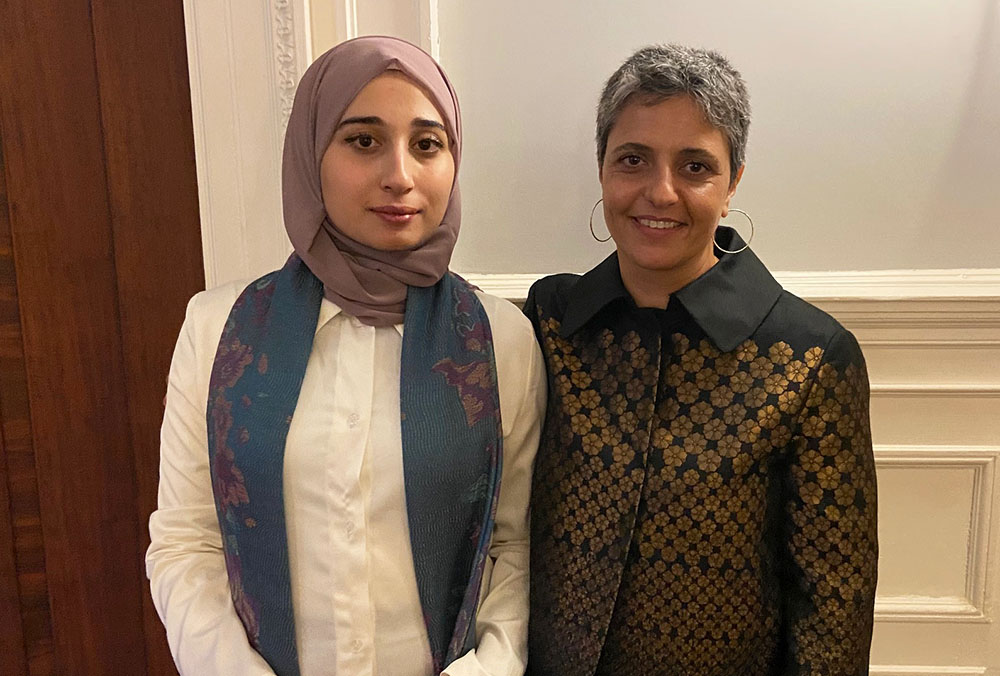Describing the Indescribable: To Be–Named: Palestine Exhibit Focuses on Grieving and Survival
"For the heart, a heart," a manipulated image from Samar Hazboun’s “Family Archive Project" in EHCN's “To Be–Named: Palestine" exhibit.
Vivien Sansour’s curator statement for “To Be–Named: Palestine,” an online exhibit she co-curated with Melina Roise as part of the Experimental Humanities Collaborative Network’s (EHCN) To Be–Named global project, encapsulates the probing, purposeful work of seven Palestinian artists asking if language and naming can help keep a society or culture alive in the face of violent destruction.
Naming as a Necessity
“Naming something such as our current trauma is no longer a matter of mere intellectual exercise, it has become of utmost necessity to help us get through and hopefully be able to heal from it, if we ever will,” writes Sansour, referring to the effects of Israel’s deadly war on Gaza and the West Bank.
The larger To Be–Named project website explains that the show “reflects upon how names are created and used to shape, reshape, and sometimes mis-shape, our worlds, and identities. The project started over three years ago when it emerged from a partnership between EHCN, Recovering Voices at the National Museum for Natural History at the Smithsonian Institution, and the EU-funded CoLing project. The Palestine show is part of an international touring exhibit that has already been to Germany, Greece, US, Kyrgyzstan, Mexico, and the Republic of Sakha (online) and will next travel to Bogotá, Colombia in 2026. The exhibit features a core group of films, sound installations, and photographs created by international artists, supplemented by works from local artists at each site.
Curation and the Grieving Process
During a recent event at Bard College marking the opening of the Palestine show, Sansour explained that it was originally slated to take place in the West Bank but was forced to move online as the cumulative effects of Israel’s war on Gaza have killed between 41,000 (according to the Gaza Ministry of Health) and 186,000 (according to a Lancet journal study) Palestinians.
Sansour said that in developing the exhibit over the past year she and the participating artists grappled with intense questions such as: what is the role of art in such difficult times and what might the new realities that these artworks envision look like? Names and words can be helpful but they can also be oppressive, said Sansour. In the end, curating the works turned out to be more of a ritualistic practice for processing grief and loss together, she said. All of the pieces in the show reflect this process.

To Be–Named: Palestine curator Vivien Sansour (right) and artist Raneem Ayyad attend the project opening event at Bard College.
Samar Hazboun’s “Family Archive Project,” a series of manipulated family snapshots, examines the artist’s journey “in search of identity and a father lost to detainment.” In the accompanying text, the photographer writes about her struggle to select a photo that expresses the experience of growing up in Palestine, raised by a loving father who was at one point detained in an Israeli prison for two years and returned home depressed and diminished. “How I wish to take a photo of him smiling or laughing—just a true photo of him, not of the man the political situation turned him into,” she writes.
“Mama,” a video installation by Bisan Abu Eisheh, features the artist's interview with his mother and his realization that he has overlooked her pivotal role in the Palestinian resistance, focusing primarily on his father. He explains that through their dialogue, his mother emerges as a “breathing archive,” offering marginalized insights to Palestinian revolutionary movements.
Saida Hamad’s “Asameena” is a series of podcasts that explore the tradition of naming children after Palestinian villages that have been destroyed or seized by Israel and renamed in Hebrew. In her commentary, Hamad notes that the practice reflects refugees’ aspirations to one day return to a decolonized homeland. All of the recordings reflect the painful recollections of individuals born and raised with a constant longing for something that is gone.
“Al-Jisr /The Bridge” by Raneem Ayyad features English and Arabic text and visual collage that capture the artist's experience crossing the Palestinian-Jordanian border as a child between 2004 and the 2010s. Juxtaposing archival border control documents with colorful ink drawings by four-year-old Palestinian-American Leyl Abu Rish, the visual component of the work illustrates the traumatic clash between childhood and political borders. The artist’s written recollections aptly describe the anxiousness and confusion faced by Palestinians who attempt to travel between Palestine and Israel.
Other artists in To Be—Named: Palestine include Laura Menchaca Ruiz, Khader H. Handal, Ayed Arafah, and Shada Safadi. The show was developed in collaboration with the Humanities and Practicing Arts Division at Al-Quds Bard College (AQB) in Palestine.
The works in To Be–Named: Palestine demonstrate Palestinian artists’ attempts to reckon with not only historical traumas but also persistent attempts to wipe out their culture and society. While words’ capacity to describe the indescribable may be limited, these works nevertheless convey a powerful effort to not only mourn but to survive and heal in the face of overwhelming loss.
Post Date: 10-29-2024